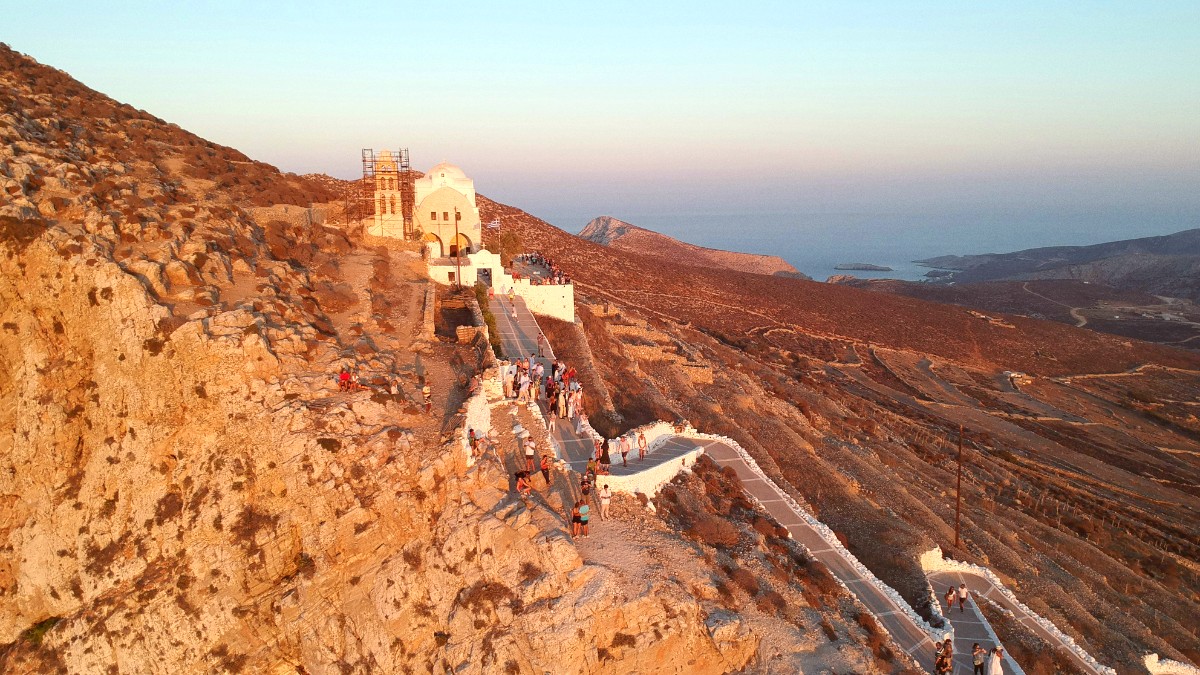
Greece
Chora (Folegandros Town): The island's capital and its most famous landmark. Perched dramatically on a cliff edge, it is a beautifully preserved traditional Cycladic village. Its design, with narrow, winding alleys and whitewashed houses, served a defensive purpose against pirate raids. The Kastro, the oldest part (13th-century Venetian rule), comprises houses built as a continuous protective wall. Explore at any time; shops and restaurants operate throughout the day and late into the evening during peak season.
The series of picturesque squares, connected by narrow passages, buzz with activity, hosting most of the island's restaurants, bars, and shops.
The walk up is steep but manageable for most visitors.
Folegandros does not present other specialized museums. Its small size means its history exists mainly through living traditions and preserved villages.
A few small, independent art shops and galleries in Chora feature works by local artists or pieces inspired by the Cycladic landscape.
No formal cultural centers. Local festivals ("panigiria") feature traditional music, dancing, and community gatherings, providing authentic cultural experiences.
Limited, mostly confined to local seasonal events or small, temporary displays within Chora's shops.
Folegandros's history is written in its landscape and living architecture.
Remains of the island's ancient city near Ano Meria. Mostly foundations and scattered ruins.
Evidence of Roman presence, these ancient cisterns near Ano Meria indicate past water management.
An outstanding example of a living historical district, a medieval fortified settlement.
Numerous small whitewashed churches and chapels dot the landscape, often in scenic, secluded spots.
An outstanding example of a living historical district. This medieval fortified settlement presents houses built into a defensive wall. Wander through centuries of history still inhabited today.
Remains of the island's ancient city near Ano Meria. Mostly foundations and scattered ruins. The site presents a sense of long history and provides excellent views.
Numerous small whitewashed churches and chapels dot the Folegandros landscape. Many built in secluded, scenic spots, presenting quiet places for reflection and superb panoramic views.
No major national memorials exist on Folegandros, but local monuments commemorate historical figures or events in the main villages.
Folegandros's rugged nature and stunning coastline are its premier natural attractions.
Main hub for boat trips to other secluded beaches. Accessible by bus, car, scooter. Offers tavernas and some sunbeds/umbrellas. Family-friendly and lively atmosphere.
Popular for its clear waters and a small, charming church nearby. Reachable by boat from Agali or a moderate hike. Features a taverna and some natural shade. Relaxed ambiance, some naturism.
Considered one of the island's best, with stunning, clear turquoise waters. Access is more challenging, either by boat from Karavostasi/Agali or a demanding hike. No facilities. Secluded and truly stunning.
Excellent for snorkeling in its calm, clear waters. Reachable by boat from Agali or a moderate hike. No facilities. Quiet and beautiful.
Explore Snorkeling ToursA quiet, secluded rocky beach, ideal for tranquility and those seeking true isolation. Reachable by car/scooter plus a short hike. No facilities.
Find Hidden GemsThe Church of Panagia offers the best panoramic views. The Lighthouse of Aspropounta presents dramatic cliffside views after a challenging hike.
Discover ViewpointsWildlife is limited, mainly birds and goats. Coastal areas are Natura 2000, important for migratory birds and monk seals. Dramatic cliffs and sea caves (Chrysospilia) dot the coastline.
Learn MoreFolegandros does not feature formal parks or extensive gardens. The island's natural landscape itself serves as its "park"—a rugged, terraced environment with sparse Mediterranean vegetation.
Beyond well-known spots, Folegandros holds less-visited treasures for the curious traveler.
Explore less-visited treasures and unique experiences.
Prioritize attractions based on your interests. Group nearby sites to optimize travel time between locations.
Public buses connect Chora, Karavostasi, Agali, and Ano Meria.
Folegandros's terrain is hilly, and many paths are cobbled or unpaved. This can present challenges for visitors with mobility concerns.
Plan accordingly, considering the physical demands of certain attractions.
Prepare for sun, heat, and varied terrain to fully enjoy your sightseeing.
Lightweight clothing and swimwear are also recommended for beach visits.
Engage with locals for authentic tips and current information on attractions.
Embrace the island's slow pace and discover its charm at your leisure.
Utilize platforms like GetYourGuide for attraction tickets and tour bookings.
Check with your accommodation or local information points for maps, bus schedules, and latest updates.
Acquire detailed hiking maps (e.g., Anavasi) for exploring the island's extensive trail network.